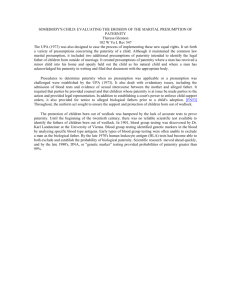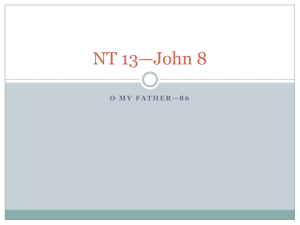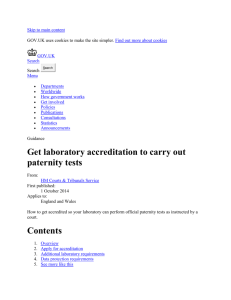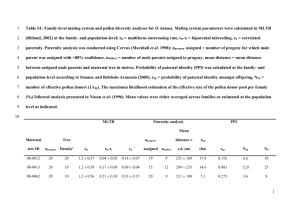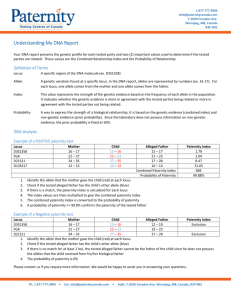Section 2: Legal and Other Fathers
advertisement
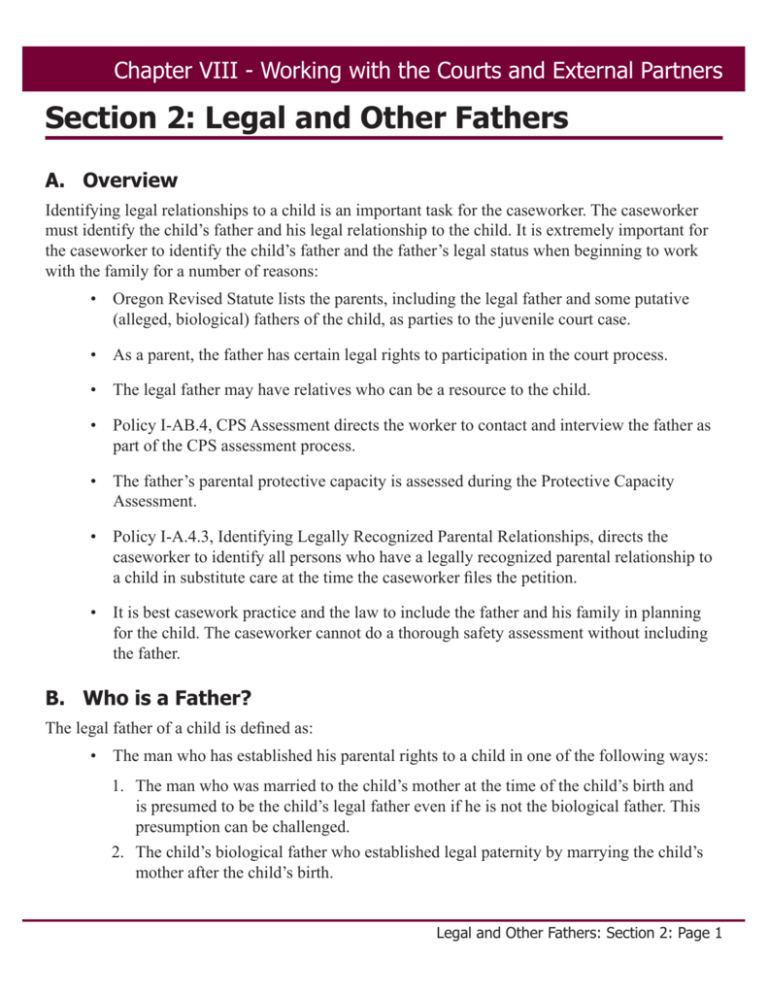
Chapter VIII - Working with the Courts and External Partners Section 2: Legal and Other Fathers A. Overview Identifying legal relationships to a child is an important task for the caseworker. The caseworker must identify the child’s father and his legal relationship to the child. It is extremely important for the caseworker to identify the child’s father and the father’s legal status when beginning to work with the family for a number of reasons: • Oregon Revised Statute lists the parents, including the legal father and some putative (alleged, biological) fathers of the child, as parties to the juvenile court case. • As a parent, the father has certain legal rights to participation in the court process. • The legal father may have relatives who can be a resource to the child. • Policy I-AB.4, CPS Assessment directs the worker to contact and interview the father as part of the CPS assessment process. • The father’s parental protective capacity is assessed during the Protective Capacity Assessment. • Policy I-A.4.3, Identifying Legally Recognized Parental Relationships, directs the caseworker to identify all persons who have a legally recognized parental relationship to a child in substitute care at the time the caseworker files the petition. • It is best casework practice and the law to include the father and his family in planning for the child. The caseworker cannot do a thorough safety assessment without including the father. B. Who is a Father? The legal father of a child is defined as: • The man who has established his parental rights to a child in one of the following ways: 1. The man who was married to the child’s mother at the time of the child’s birth and is presumed to be the child’s legal father even if he is not the biological father. This presumption can be challenged. 2. The child’s biological father who established legal paternity by marrying the child’s mother after the child’s birth. Legal and Other Fathers: Section 2: Page 1 Chapter VIII - Working with the Courts and External Partners 3. The biological father who, with the child’s mother, filed a voluntary acknowledgement of paternity with the Oregon Center for Health Statistics (Vital Statistics). 4. The biological father whose legal paternity has been established by filiations proceeding. 5. The father whose legal paternity has been established by some other judicial order, including adoption of the child. 6. If the child was born in a state other than Oregon, legal paternity may have been established by other means according to the laws of that state (e.g., common-law marriage). 7. In Indian Child Welfare cases, a man who is the father under applicable tribal law. The putative father of a child is defined as: • A Stanley putative father is a party to the juvenile court case and is the biological father of a child who has never legally established paternity as outlined above, but who has assumed or attempted to assume the responsibilities normally associated with parenthood (e.g., has lived with the child, financially supported the child, established significant psychological ties to the child) and has legal rights to the child. • A Pagan putative father who is an alleged biological father who has not assumed or attempted to assume parental responsibilities. • An “other” putative father includes a man who is the biological father and who has had or has attempted to have some contact and attempted to provide some for the child, or a named biological father of a child placed immediately in foster care, or a man claiming or alleged to be the biological father and paternity is being addressed in court. See Appendix 2.1 for the chart Fathers at a Glance and Search and Notice Requirements for additional information regarding fathers. This tool is also available at the DHS website: http://www.dhs.state.or.us/training/caf/paternity_tools/ Procedure • Complete the form CF 418 with the mother of the child at the start of working with the family. This form, called the Father’s Questionnaire, provides information to confirm the father’s status or to determine if he is a father with legal rights to the child. • Identify the legal status of the named father of a child by naming him on the petition if legal or Stanley, describe how he is the legal or putative father, and document this status Section 2: Page 2: Legal and Other Fathers Chapter VIII - Working with the Courts and External Partners in a case note in FACIS. Do not name a man on the petition if you are unsure of his legal status. • Consult with your supervisor or an AAG (with your supervisor’s approval) if you have questions regarding the legal status of a father, including the possibility of having two legal fathers for a child. There are many resources to help you find information regarding a putative or legal father. Child Welfare screens accessed through FACIS and IIS, Birth Browse, Division of Child Support (DCS) screens and Self Sufficiency Program (SSP) screens may be used. Check with your CMC for assistance if you do not know how to access those screens. Remember to document your search results in the case notes section in FACIS. The State Recovery Central Unit (SRCU), a unit within DCS, can assist caseworkers in identifying if and how paternity has been established. Contact SRCU to inquire about the status of establishment proceedings when DCS has an open case. Provide updated information to DCS to assist in their efforts to establish paternity. Find their contact information on the DHS paternity tools website: http://www.dhs.state.or.us/training/caf/paternity_tools/ at State Recovery Central Unit (SRCU). The caseworker uses Form CF 5600-Child Welfare Parentage Testing and Division of Child Support Notification to notify SRCU about a paternity issue. Procedure • Obtain supervisor approval for DHS to facilitate parentage testing through LabCorp (Box 3). • Complete case information fields (Box 1) and fax a copy of the CF 5600 to LabCorp, DCS and central office using the numbers provided on the form (Boxes 2 & 3). • Notify DCS any time paternity is addressed as an issue in a juvenile court proceeding (Box 2). • Forward to DCS a Voluntary Acknowledgement of Paternity or a certified copy of an order establishing or dis-establishing paternity (Box 2). Legal and Other Fathers: Section 2: Page 3 Chapter VIII - Working with the Courts and External Partners C. During the CPS Assessment The CPS worker completing a CPS assessment identifies and contacts the father with rights to a child. The father with rights is interviewed by the CPS caseworker to gather information relevant to determining child safety. The father is entitled to receive Pamphlet 1536, regarding the CPS process; the assessment disposition; and Pamphlet 9027 regarding notice if the child is placed in foster care. The caseworker receives an exception for some notification in cases of domestic violence but must provide notice to the father with rights if the child is placed out of the home and the juvenile court is involved with the child. Procedure The caseworker will: • Locate the father when it has been determined the named father is a father with rights. • Ask the child’s mother and other maternal and paternal relatives to assist in locating the father. • Initiate an Absent Parent Search in open cases if the father’s whereabouts are unknown. Initiate this search by the 60th day of any open case with court involvement. See Chapter II: Screening and Assessment sections on Identifying Legal Parents and Absent Parent Search for the detailed procedures to follow when searching for the father. • Provide notice to and include the father who has rights in case planning. A legal father or a Stanley father is a party to any court action taken on behalf of a child. The father has the right to notice of hearings; copies of petitions, answers, motions and other papers; request counsel be appointed to represent him; call witnesses, cross-examine witnesses and participate in hearings; appeal; and request a hearing. • Determine how a father has established paternity or is considered a legal party and document that information in a case note in FACIS. • The Indian Child Welfare Act applies if the named father of a child is a member of or eligible for membership in a federally recognized tribe and the named father acknowledges he is the father consistent with tribal law. This father is considered the legal father even if he has not legally established paternity through the state of Oregon. He is a father with rights. Provide active efforts to the family and discuss with the father ways to establish legal paternity. This includes providing information about the local Division of Child Support office, including the address and phone number. Contact the DCS State Recovery Central Unit for assistance. • List a legal father and a Stanley father on any dependency petition filed and provide notice of the hearing to this father. Section 2: Page 4: Legal and Other Fathers Chapter VIII - Working with the Courts and External Partners • Provide information to the court regarding the status of the legal father and how he was established as the legal father. Provide this information either orally to the judge or in a court report. • Assist a Stanley putative father who has not established paternity but has assumed or attempted to assume parental responsibility for the child to establish legal paternity. Provide information about the local Division of Child Support, including the address and phone number or contact DCS State Recovery Central Unit for assistance. • Treat the Stanley father as a parent in case practice; however, his relatives will not be considered as relatives to the child unless he establishes legal paternity. • Include the Stanley father in a dependency petition filed with the juvenile court, as the juvenile court recognizes this Stanley putative father as a father with rights in the juvenile dependency matter with the same rights as listed above for a legal father. • The caseworker is not obligated to contact a father who fits the definition of a Pagan father, as this father has not assumed or attempted to assume parental responsibility, does not have a legally recognized relationship with the child and has no rights in the juvenile court dependency case. If a Pagan father contacts you, consult with your supervisor about his potential legal status and including the father in case planning. • Consult with your supervisor and an AAG (with supervisor approval) regarding the legal status of an “Other” type of father if you are unsure of his standing. • If a Stanley father is not present at the time of the initiation of a court proceeding, write the Stanley putative father a letter using the same local procedure as you would to notify a legal father. • Send notification in the form of a “Randolph Jones” letter to the “Other” category of putative fathers, including named father of an infant placed in protective custody from the hospital following the child’s birth. See Chapter V: Adoption, Determination of Legal Parties for more information regarding this letter. See Appendix 2.2 for an example of a “Randolph Jones” letter. The caseworker is not obligated to provide the putative father of a child with additional notice if he does not respond to the “Randolph Jones” letter within the time frames outlined in the letter. If this father contacts you after the timelines, consult with your supervisor about his potential legal status and including this father in case planning. See Appendix 2.1 for the chart Fathers at a Glance and Search and Notice Requirements for additional information regarding fathers. This tool is also available at the DHS website: http://www.dhs.state.or.us/training/caf/paternity_tools/ Legal and Other Fathers: Section 2: Page 5 Chapter VIII - Working with the Courts and External Partners D. When to Consult • Review the putative father’s status with your supervisor to verify the father’s status if you are unsure of a father’s status. • Consult with Central Office program consultants, a paralegal or the general counsel assistant attorney general (AAG) if there continues to be questions about a father’s status between you and your supervisor. Uncertainty may exist when a father has had some contact with the child but has not had a significant relationship with the child. • Consult with your supervisor and the general counsel AAG for assistance when it is possible there are two fathers with a legally recognized relationship to the child. • Consult with your supervisor on fathers who fall between the category of “Stanley” and “Pagan” fathers to insure consistency of practice within the department. • Consult with your supervisor if a question regarding paternity arises in a case and consult with the general counsel AAG when a hearing regarding paternity may be needed. ORS 419B.395 gives the juvenile court authority to address issues of paternity when there is no legal father or there is a legal father but his paternity is in dispute. • Contact and consult with the Division of Child Support/State Recovery Central Unit on issues regarding paternity using the CF 5600 form. • Contact the legal assistance AAG and the legal assistance specialist on paternity questions if pursuing termination of parental rights. See Chapter V: Adoptions for a more detailed description of this procedure. Role of the Supervisor • Consults with a caseworker regarding the paternity status of fathers and reviews the Father’s Questionnaire to confirm fathers with rights of participation. • Consults with the caseworker and the Central Office program consultants, paralegals and the general counsel AAG about any questionable status of a named father of a child. • The supervisor consults with the caseworker to ensure appropriate partnering with DCS/ SRCU occurs, including approval of funds for paternity testing. Section 2: Page 6: Legal and Other Fathers Chapter VIII - Working with the Courts and External Partners Legal References • ORS 109.070 • ORS 109.096 • ORS 419B.875 (1) (a) (B) • ORS 419B.875 (2) (a) through (e) • ORS 419B.875 (1) (a) (C) • ORS 419B.395 • DHS policy I-A.4.3: Identifying Legally Recognized Parental Relationships http://www.dhs.state.or.us/policy/childwelfare/manual_1/i-a43.pdf • DHS policy I-AB.4: CPS Assessment http://www.dhs.state.or.us/policy/childwelfare/manual_1/i-ab4.pdf Forms • CF 418 Father’s Questionnaire http://dhsforms.hr.state.or.us/Forms/Served/ce0418.pdf • CF 5600 Child Welfare Parentage Testing and Division of Child Support Notification http://www.dhs.state.or.us/training/caf/paternity_tools/ • Pamphlet 1536: What You Need to Know about a Child Protective Service Assessment http://dhsforms.hr.state.or.us/Forms/Served/ce1536.pdf • Pamphlet 9027: If Your Child is in the Custody of DHS Legal and Other Fathers: Section 2: Page 7

